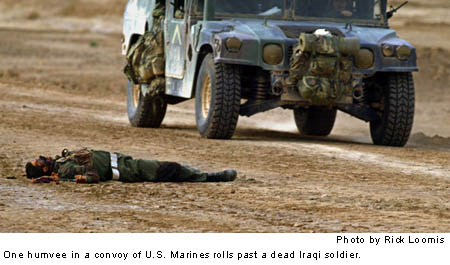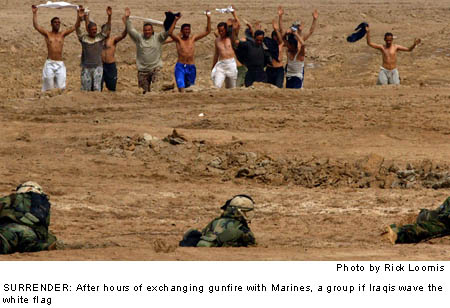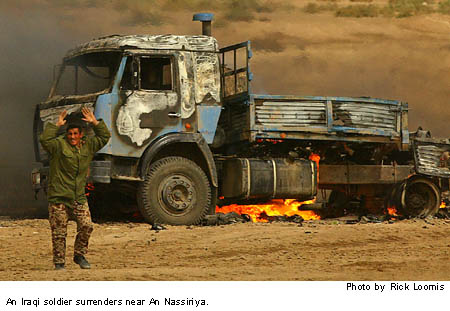|
|
||||
I left Kuwait and crossed into Iraq with the Marines on March 20th, 2003. Two days later I celebrated my birthday by eating an MRE pound cake in a windblown expanse of empty desert. Three weeks later I was sleeping on the floor of Saddam Hussein's vacated Presidential Palace. And during the days in between, the harsh realities of war were not only realized, but emblazoned reluctantly in my memory. Before the war started I wondered if there would really be a war. There was a lot of U.S. saber-rattling going on. I was worried about being a member of the embedded media. Would there be unfettered access or would the military just use us as a propaganda tool, allowing us to show only what made the U.S. look good ? Would I, or any journalist for that matter, ever be on the front lines of the war ? After being fired upon by small arms, mortars, rocket-propelled grenades and mobile missile launchers, I no longer questioned whether embedded journalists would be put in harm's way. The press asked for it and they got all the danger one could ask for.
As an "embed," a journalist assigned to a specific military unit, both in Afghanistan and most recently in Iraq, I have taken away many lessons learned from my experiences. I have gained insight into how the military actually operates on a daily basis. It seems the military has little appreciation for journalists who parachute in to cover a story and then leave. On the other hand, embeds receive a fair amount of respect for experiencing and enduring the same moments of boredom, frustration, fear and action as they do. In fact, there is an added amount of respect since we are willing to put our lives on the line with them, unarmed. And unlike members of the military, we do not receive danger pay, added life insurance benefit earned through death while on duty nor do we enjoy their same tax-free status while working abroad. They were also surprised to learn that we volunteered to cover the war. Many of them thought we were crazy. A few Marines would call out, it's the reporter with a death wish, when they saw me. But I was just trying to do my job. The unit I traveled with was the 1st Battalion, 4th
Marines out of Camp As I've been told by soldiers and Marines in the past, their job is sometimes filled with days of sheer boredom broken by moments of sheer terror. After crossing uneventfully into Iraq from Kuwait, my unit was merely one vehicle in an endless stream of vehicles that were pouring across the border like ants headed to a grand feast. Once we were deep into Iraq territory it was boredom instead of action that became the mainstay. When were we going to be the proverbial "tip of the spear?" I would question out loud to people I knew had no idea themselves.
As a representative of one of the largest newspapers in the U.S., I was frustrated with the possibility of at being behind other journalists on the trek north. But I knew I was, and there was nothing I could do. I had no mobility, no contact with higher military representatives and could only operate within the confines of the battalion to which I was assigned. The Chicken Truck rolled on and I joked about writing a memoir titled, "Idling to Baghdad." But all of that changed as we rolled into An Nassiriya, a southern town of several hundred thousand and a place which continued its resistance for weeks after we rolled through. An advance unit had managed to set a picket line through town with Marines lying prone on both sides of the road. The only turf they held was the road we used to continue our advance north. It was nighttime when we made our dash through. As we prepared to leave, the lieutenant kept it brief. "All the shit we have been training for, this is it gents; this is the real deal. Any more questions? Get the cobwebs out of your head, do what you've got to do, make peace with your maker, whatever you gotta do, and let's go whoop some ass." With that, AC/DCs lyrics "For those about to rock, we salute you" came blaring from loudspeaker affixed to the top of a Humvee that was normally used for Arabic speakers to communicate with local Iraqis. I can only imagine what any Iraqis hiding off in the darkness were thinking as they heard the roar of tanks and loud rock and roll filling the nighttime air. Artillery and mortars pierced the night with fiery flash as they shot toward An Nassiriya a few kilometers north of our position. Our orders were to push through and not to engage in the fight going on there more than necessary. A night vision monocular allowed me to see the scene in a grainy green reality as we moved through.. Marines were lying in shooting positions on either side of the road. Gun smoke and the sharp scent of burning rubble of bombed out buildings filled my nose. I could make out the remnants of a Marine amphibious assault vehicle that looked to have been blown up by Iraqi fighters, a gaping hole in its side. Red tracer rounds sliced across the darkened sky. Illumination rounds fired from mortar tubes floated slowly from the heavens on parachutes, allowing U.S. forces to shed some light on Iraqi positions shrouded by darkness. Gunshots sounded from all directions, leaving the uneasy feeling that enemy forces were surrounding us. I could hear shouting directed at our vehicle. From the darkness only a few feet away, a panicked and angry voice registered over the gunfire. A Marine was standing next to driver' door in the dark screaming, "You got a radio?" "Yes," came the reply from inside our vehicle. The voice outside shot back, "You need to tell those fucking people in the front there's friendlies up there. We are fucking lined up all along the road. Call 'em and tell 'em. No fucking shooting," he yelled, and the voice receded from where it came. "We need to cease fire on that building. They say they are our people up there," said our vehicle commander muttered nonchalantly into the radio, alerting the rest of the unit. I had just witnessed my first friendly fire incident. As I watched, U.S. Marines come under fire from their own, I came to understand how it could have happened. It's the "fog of war" and I am one of the few journalists who now have some insight into its reality. The Marines who were shot had been on the second floor of a building; a building that came to be illuminated only because of the heavy fire wrought down upon it. They were wounded but lived, I was told later. It was a sleepless night as we survived our run through An Nassiriya only to become even more involved in battle during the following days. The elusive front line I had been seeking for days was within my sight. We were finally, for a moment, the "tip of the spear." I watched and photographed as Cobra helicopters fired on targets with Hellfire missiles, and on the ground our CAAT platoon was registering its own "kills" with TOW missiles. As we advanced north, the gruesomeness of war was still fresh. Bloody bodies were pouring out of civilian buses and cars. These were the civilian vehicles that had been suspected of transporting Iraqi troops south toward our position to join the fight. Some of the bodies were in uniform, others were in civilian clothes. It would be impossible to sort out combatants from those who were in the wrong place at the wrong time. As we moved past a scene in slow motion, I raised my camera to photograph a body lying next to a burned out car. After I had taken one or two frames, I saw that the body was of a child around 10 years old. Then I saw the body was moving. I shouted to the vehicle commander that a child was injured but alive in the road and he passed the information over the radio. Though we had a medic in our Humvee, the convoy kept rolling. Some Iraqis were not so lucky as to simply be killed. A few corpses were turned into barely recognizable "human pizzas" as entire convoys of vehicles rolled over them in the roadway. There was no dignity with death among these unlucky ones.
After being pounded by U.S. Marines in the air and on the ground, I watched Iraqis emerge from the distant tree lines, hands in the air. One man waved an oversized white flag. It was a sight to see and also an important photograph among others I had just taken.
Deadline was approaching in Los Angeles and I wanted to offer these photos to the editors there. Sporadic gunfire was still erupting from both sides but I wanted to take advantage of the pause in our movement to transmit. Just about the time the photos started streaming via satellite phone bit by bit into space, bound for the relative calmness of an L.A. office building, our Humvee started moving again. As it traversed this way and that way over the bumpy terrain, I tried to maintain the satellite signal by hand-holding the antennae to keep it pointed in a southerly direction. Surprisingly it worked and the photos made it through for consideration.
Goto Part II of CPL. Teasley by Rick Loomis Rick Loomis |
|
|
Write a Letter
to the Editor |



